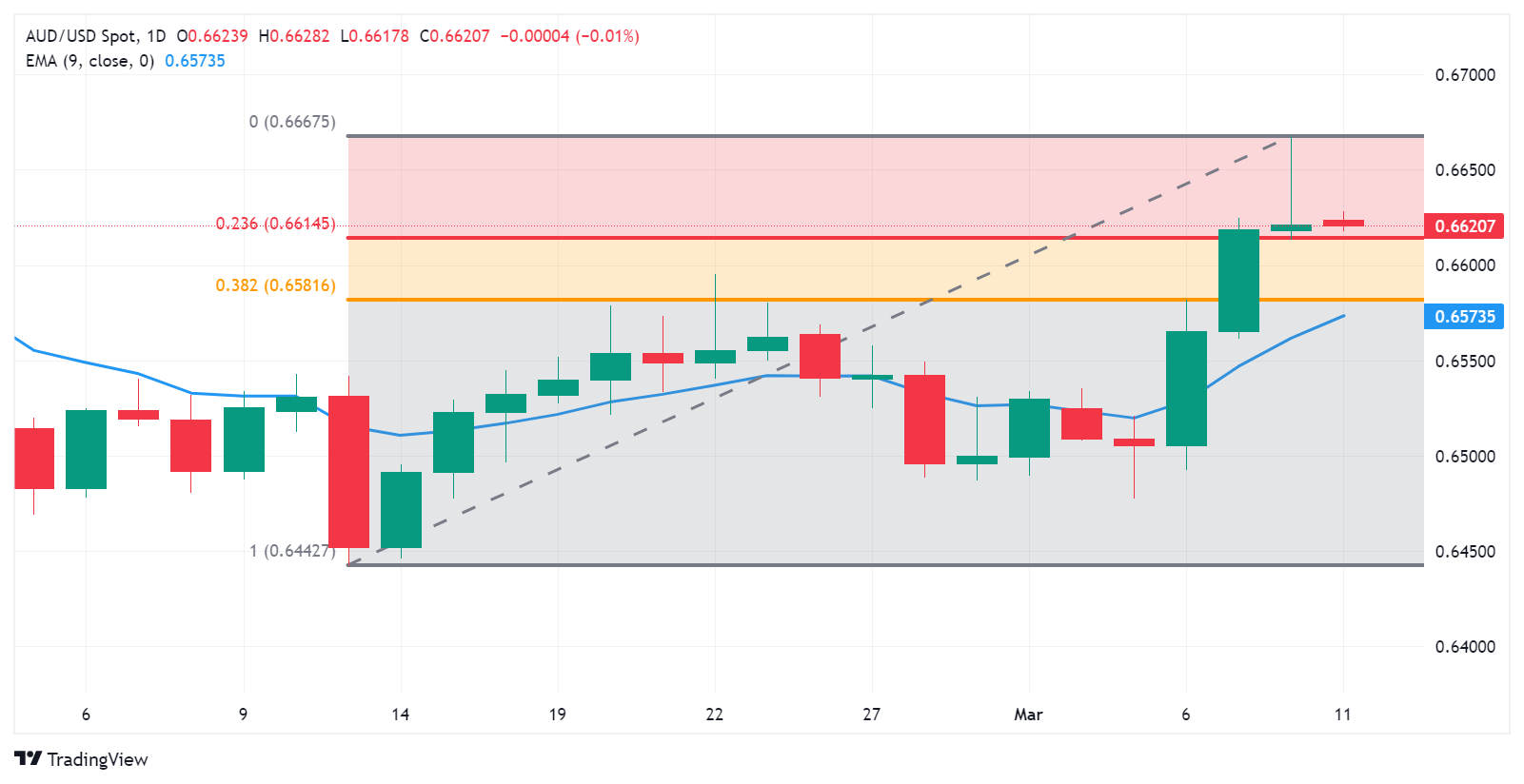- Australian Dollar halts its winning streak amid a muted US Dollar.
- Australia’s S&P/ASX 200 Index retreats from all-time highs as investors booked profits.
- China's CPI YoY and MoM increased by 0.7% and 1.0%, respectively, in February.
- US Nonfarm Payrolls rose by 275K in February, surpassing the expected 200K and 229K prior.
The Australian Dollar (AUD) snaps its three-day winning streak on Monday, amid a weaker US Dollar (USD). The benchmark S&P/ASX 200 Index witnessed a decline at the beginning of the week, retreating notably from all-time highs as investors booked profits. The drop was particularly pronounced in the materials and healthcare sectors. Additionally, Australian shares followed a decline in technology stocks on Wall Street on Friday, which has tempered the strength of the AUD/USD pair.
Australian Dollar experienced a 1.60% gain against the US Dollar last week, driven by increasing expectations that the US Federal Reserve (Fed) will initiate interest rate cuts earlier than other major central banks. However, the Australian economy expanded less than anticipated in the fourth quarter, and the Trade Balance surplus fell short of expectations. These economic indicators highlight the argument for the Reserve Bank of Australia (RBA) to potentially consider rate cuts in the near future.
The US Dollar Index (DXY) maintains its position as traders adopt a cautious stance ahead of US Consumer Price Index (CPI) data for February, scheduled for Tuesday. Investors will closely monitor a panel discussion at the AFR Business Summit in Sydney on Tuesday, where Sarah Hunter, Assistant Governor (Economics) at the Reserve Bank of Australia, may provide insights on domestic inflation trends. Additionally, attention will be on the release of the Australian Westpac Consumer Confidence for March.
Daily Digest Market Movers: Australian Dollar depreciates on weaker equity market
- Australian Trade Balance (MoM) showed that the surplus increased to 11,027M in February, from 10,743M prior. The market expectation was an increase to 11,500M.
- Australian Gross Domestic Product (GDP) grew by 0.2% QoQ in the fourth quarter of 2023, slightly below market expectations of no change at 0.3%. GDP (YoY) expanded by 1.5%, surpassing the expected 1.4%, but falling short of the previous growth of 2.1%.
- Australia's Treasurer, Jim Chalmers, has announced that the government will abolish nearly 500 import tariffs on a wide range of goods starting from July 1, 2024. This initiative aims to reduce compliance costs for businesses. By removing these tariffs, approximately A$8.5 billion worth of annual trade will be streamlined, leading to savings of over A$30 million in compliance costs for businesses each year.
- In February, China's Consumer Price Index (CPI) increased by 0.7% year-over-year, rebounding from a 0.8% decline in January and surpassing market expectations of a 0.3% rise. CPI inflation (MoM) rose by 1.0%, up from a 0.3% increase seen in January and exceeding the market consensus of 0.7%.
- Chinese Producer Price Index (PPI) dropped by 2.7% YoY in February, compared to a 2.5% decline in January. This data came in weaker than market expectations, which anticipated a 2.5% decline.
- Federal Reserve (Fed) Chair Jerome Powell, in his s testimony before the US Congress last week, reaffirmed the central bank's position. Powell hinted at potential cuts in borrowing costs sometime this year. However, he emphasized that such actions would hinge on the inflation trajectory aligning with the Fed's target of 2%.
- Cleveland Fed President Loretta Mester addressed the Virtual European Economics and Financial Center, expressing concerns about the potential persistence of inflation throughout the year. She indicated that if the economy aligns with forecasts, there could be a likelihood of rate cuts later in the year.
- According to the CME FedWatch Tool, there has been a slight decrease in the probability of a rate cut in March and May, with chances at 3.0% and 24.5%, respectively. However, the likelihood of a 25 basis points rate cut has increased to 57.2% for June.
- US Nonfarm Payrolls increased by 275K in February, surpassing January's figure of 229K and beating expectations of 200K.
- US Average Hourly Earnings (YoY) grew by 4.3%, falling slightly below both February’s estimated and previous reading of 4.4%. On a monthly basis, there was an increase of 0.1%, which was lower than the anticipated 0.3% and the previous month's 0.5%.
- US Initial Jobless Claims were unchanged at 217K for the week ending on March 1, against the expected 215K.
- US Nonfarm Productivity remained consistent at the growth of 3.2% in the fourth quarter of 2023, exceeding the market expectation of 3.1%.
- February’s US ADP Employment Change came in at 140K against the expected 150K, increasing from 111K prior.
Technical Analysis: Australian Dollar hovers around 0.6620 followed by the previous week’s high
The Australian Dollar traded around 0.6620 on Monday. Key resistance appears at the major level of 0.6650, followed by the previous week’s high of 0.6667. A break above this level could support the pair to test the psychological barrier of 0.6700 level. On the downside, the immediate support appears at the 23.6% Fibonacci retracement level of 0.6614 followed by the psychological level of 0.6600. A break below the latter could push the AUD/USD pair to navigate the region around the 38.2% Fibonacci retracement level of 0.6581, aligned with the nine-day Exponential Moving Average (EMA) at 0.6574.
AUD/USD: Daily Chart
Australian Dollar price today
The table below shows the percentage change of Australian Dollar (AUD) against listed major currencies today. Australian Dollar was the weakest against the Swiss Franc.
| USD | EUR | GBP | CAD | AUD | JPY | NZD | CHF | |
| USD | 0.00% | 0.00% | -0.01% | 0.13% | 0.10% | 0.03% | -0.03% | |
| EUR | -0.02% | 0.02% | -0.02% | 0.13% | 0.09% | 0.02% | -0.05% | |
| GBP | 0.00% | 0.00% | -0.02% | 0.13% | 0.11% | 0.04% | -0.01% | |
| CAD | 0.02% | 0.01% | 0.01% | 0.14% | 0.10% | 0.04% | 0.00% | |
| AUD | -0.13% | -0.13% | -0.13% | -0.15% | -0.02% | -0.09% | -0.16% | |
| JPY | -0.09% | -0.11% | 0.14% | -0.12% | 0.03% | -0.07% | -0.11% | |
| NZD | -0.03% | -0.04% | -0.04% | -0.06% | 0.09% | 0.07% | -0.06% | |
| CHF | 0.01% | 0.02% | 0.02% | 0.01% | 0.14% | 0.10% | 0.04% |
The heat map shows percentage changes of major currencies against each other. The base currency is picked from the left column, while the quote currency is picked from the top row. For example, if you pick the Euro from the left column and move along the horizontal line to the Japanese Yen, the percentage change displayed in the box will represent EUR (base)/JPY (quote).
Australian Dollar FAQs
What key factors drive the Australian Dollar?
One of the most significant factors for the Australian Dollar (AUD) is the level of interest rates set by the Reserve Bank of Australia (RBA). Because Australia is a resource-rich country another key driver is the price of its biggest export, Iron Ore. The health of the Chinese economy, its largest trading partner, is a factor, as well as inflation in Australia, its growth rate and Trade Balance. Market sentiment – whether investors are taking on more risky assets (risk-on) or seeking safe-havens (risk-off) – is also a factor, with risk-on positive for AUD.
How do the decisions of the Reserve Bank of Australia impact the Australian Dollar?
The Reserve Bank of Australia (RBA) influences the Australian Dollar (AUD) by setting the level of interest rates that Australian banks can lend to each other. This influences the level of interest rates in the economy as a whole. The main goal of the RBA is to maintain a stable inflation rate of 2-3% by adjusting interest rates up or down. Relatively high interest rates compared to other major central banks support the AUD, and the opposite for relatively low. The RBA can also use quantitative easing and tightening to influence credit conditions, with the former AUD-negative and the latter AUD-positive.
How does the health of the Chinese Economy impact the Australian Dollar?
China is Australia’s largest trading partner so the health of the Chinese economy is a major influence on the value of the Australian Dollar (AUD). When the Chinese economy is doing well it purchases more raw materials, goods and services from Australia, lifting demand for the AUD, and pushing up its value. The opposite is the case when the Chinese economy is not growing as fast as expected. Positive or negative surprises in Chinese growth data, therefore, often have a direct impact on the Australian Dollar and its pairs.
How does the price of Iron Ore impact the Australian Dollar?
Iron Ore is Australia’s largest export, accounting for $118 billion a year according to data from 2021, with China as its primary destination. The price of Iron Ore, therefore, can be a driver of the Australian Dollar. Generally, if the price of Iron Ore rises, AUD also goes up, as aggregate demand for the currency increases. The opposite is the case if the price of Iron Ore falls. Higher Iron Ore prices also tend to result in a greater likelihood of a positive Trade Balance for Australia, which is also positive of the AUD.
How does the Trade Balance impact the Australian Dollar?
The Trade Balance, which is the difference between what a country earns from its exports versus what it pays for its imports, is another factor that can influence the value of the Australian Dollar. If Australia produces highly sought after exports, then its currency will gain in value purely from the surplus demand created from foreign buyers seeking to purchase its exports versus what it spends to purchase imports. Therefore, a positive net Trade Balance strengthens the AUD, with the opposite effect if the Trade Balance is negative.
Information on these pages contains forward-looking statements that involve risks and uncertainties. Markets and instruments profiled on this page are for informational purposes only and should not in any way come across as a recommendation to buy or sell in these assets. You should do your own thorough research before making any investment decisions. FXStreet does not in any way guarantee that this information is free from mistakes, errors, or material misstatements. It also does not guarantee that this information is of a timely nature. Investing in Open Markets involves a great deal of risk, including the loss of all or a portion of your investment, as well as emotional distress. All risks, losses and costs associated with investing, including total loss of principal, are your responsibility. The views and opinions expressed in this article are those of the authors and do not necessarily reflect the official policy or position of FXStreet nor its advertisers. The author will not be held responsible for information that is found at the end of links posted on this page.
If not otherwise explicitly mentioned in the body of the article, at the time of writing, the author has no position in any stock mentioned in this article and no business relationship with any company mentioned. The author has not received compensation for writing this article, other than from FXStreet.
FXStreet and the author do not provide personalized recommendations. The author makes no representations as to the accuracy, completeness, or suitability of this information. FXStreet and the author will not be liable for any errors, omissions or any losses, injuries or damages arising from this information and its display or use. Errors and omissions excepted.
The author and FXStreet are not registered investment advisors and nothing in this article is intended to be investment advice.
Recommended content
Editors’ Picks

Gold trades near record-high, stays within a touching distance of $3,100
Gold clings to daily gains and trades near the record-high it set above $3,080 earlier in the day. Although the data from the US showed that core PCE inflation rose at a stronger pace than expected in February, it failed to boost the USD.

EUR/USD turns positive above 1.0800
The loss of momentum in the US Dollar allows some recovery in the risk-associated universe on Friday, encouraging EUR/USD to regain the 1.0800 barrier and beyond, or daily tops.

GBP/USD picks up pace and retests 1.2960
GBP/USD now capitalises on the Greenback's knee-jerk and advances to the area of daily peaks in the 1.2960-1.2970 band, helped at the same time by auspicious results from UK Retail Sales.

Donald Trump’s tariff policies set to increase market uncertainty and risk-off sentiment
US President Donald Trump’s tariff policies are expected to escalate market uncertainty and risk-off sentiment, with the Kobeissi Letter’s post on X this week cautioning that while markets may view the April 2 tariffs as the "end of uncertainty," it anticipates increased volatility.

US: Trump's 'Liberation day' – What to expect?
Trump has so far enacted tariff changes that have lifted the trade-weighted average tariff rate on all US imports by around 5.5-6.0%-points. While re-rerouting of trade will decrease the effectiveness of tariffs over time, the current level is already close to the highest since the second world war.

The Best brokers to trade EUR/USD
SPONSORED Discover the top brokers for trading EUR/USD in 2025. Our list features brokers with competitive spreads, fast execution, and powerful platforms. Whether you're a beginner or an expert, find the right partner to navigate the dynamic Forex market.
